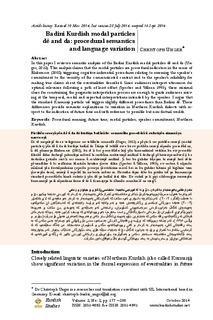| dc.contributor.author | Unger, Christoph | |
| dc.date.accessioned | 2017-06-26T11:09:00Z | |
| dc.date.available | 2017-06-26T11:09:00Z | |
| dc.date.created | 2015-09-18T15:29:19Z | |
| dc.date.issued | 2014 | |
| dc.identifier.citation | Kurdish Studies journal. 2014, 177-200. | |
| dc.identifier.issn | 2051-4883 | |
| dc.identifier.uri | http://hdl.handle.net/11250/2446894 | |
| dc.description.abstract | In this paper I review a semantic analysis of the Badini Kurdish modal particles dê and da (Un-ger, 2012). This analysis claims that the modal particles are procedural indicators in the sense of Blakemore (2002) triggering cognitive inferential procedures relating to assessing the speaker's commitment to the veracity of the communicated content and to the speaker's reliability for making true claims about the eventualities described. Since audiences interpret utterances for optimal relevance following a path of least effort (Sperber and Wilson 1995), these minimal clues for constraining the pragmatic interpretation process are enough to guide audiences arriv-ing at the temporal, modal and aspectual interpretations intended by the speaker. I argue that the standard Kurmanji particle wê triggers slightly different procedures than Badini dê. These differences provide semantic explanations to variation in Northern Kurdish dialects with re-spect to the indication of future time and with reference to possible but non-factual worlds. | |
| dc.language.iso | eng | |
| dc.publisher | Kurdish Studies / Transnational Press London | |
| dc.title | Badini Kurdish modal particles dê and da: procedural semantics and language variation | |
| dc.type | Peer reviewed | |
| dc.type | Journal article | |
| dc.source.pagenumber | 177-200 | |
| dc.source.journal | Kurdish Studies journal | |
| dc.identifier.cristin | 1265609 | |
| dc.description.localcode | Copyright © 2012-2017 Kurdish Studies for personal use only | |
| cristin.unitcode | 194,62,60,0 | |
| cristin.unitname | Institutt for språk og litteratur | |
| cristin.ispublished | true | |
| cristin.fulltext | original | |
| cristin.qualitycode | 1 | |
